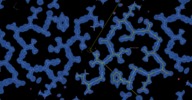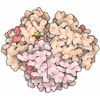+ Open data
Open data
- Basic information
Basic information
| Entry | Database: EMDB / ID: EMD-0405 | |||||||||||||||
|---|---|---|---|---|---|---|---|---|---|---|---|---|---|---|---|---|
| Title | Amyloid-Beta (20-34) with L-isoaspartate 23 | |||||||||||||||
 Map data Map data | ||||||||||||||||
 Sample Sample |
| |||||||||||||||
 Keywords Keywords | protofilament / 2 sub 1 screw symmetry / post-translational modification / isoaspartate / PROTEIN FIBRIL | |||||||||||||||
| Function / homology |  Function and homology information Function and homology informationamyloid-beta complex / growth cone lamellipodium / cellular response to norepinephrine stimulus / growth cone filopodium / microglia development / collateral sprouting in absence of injury / Formyl peptide receptors bind formyl peptides and many other ligands / axo-dendritic transport / regulation of Wnt signaling pathway / regulation of synapse structure or activity ...amyloid-beta complex / growth cone lamellipodium / cellular response to norepinephrine stimulus / growth cone filopodium / microglia development / collateral sprouting in absence of injury / Formyl peptide receptors bind formyl peptides and many other ligands / axo-dendritic transport / regulation of Wnt signaling pathway / regulation of synapse structure or activity / axon midline choice point recognition / astrocyte activation involved in immune response / NMDA selective glutamate receptor signaling pathway / regulation of spontaneous synaptic transmission / mating behavior / growth factor receptor binding / peptidase activator activity / Golgi-associated vesicle / PTB domain binding / positive regulation of amyloid fibril formation / Insertion of tail-anchored proteins into the endoplasmic reticulum membrane / Lysosome Vesicle Biogenesis / astrocyte projection / neuron remodeling / Deregulated CDK5 triggers multiple neurodegenerative pathways in Alzheimer's disease models / nuclear envelope lumen / dendrite development / positive regulation of protein metabolic process / TRAF6 mediated NF-kB activation / signaling receptor activator activity / Advanced glycosylation endproduct receptor signaling / negative regulation of long-term synaptic potentiation / modulation of excitatory postsynaptic potential / The NLRP3 inflammasome / transition metal ion binding / main axon / regulation of multicellular organism growth / intracellular copper ion homeostasis / ECM proteoglycans / regulation of presynapse assembly / positive regulation of T cell migration / neuronal dense core vesicle / Purinergic signaling in leishmaniasis infection / positive regulation of chemokine production / cellular response to manganese ion / Notch signaling pathway / clathrin-coated pit / extracellular matrix organization / neuron projection maintenance / Mitochondrial protein degradation / astrocyte activation / ionotropic glutamate receptor signaling pathway / axonogenesis / positive regulation of calcium-mediated signaling / positive regulation of mitotic cell cycle / response to interleukin-1 / protein serine/threonine kinase binding / cellular response to copper ion / platelet alpha granule lumen / cellular response to cAMP / positive regulation of glycolytic process / central nervous system development / adult locomotory behavior / positive regulation of interleukin-1 beta production / endosome lumen / dendritic shaft / trans-Golgi network membrane / positive regulation of long-term synaptic potentiation / TAK1-dependent IKK and NF-kappa-B activation / learning / positive regulation of JNK cascade / Post-translational protein phosphorylation / locomotory behavior / microglial cell activation / serine-type endopeptidase inhibitor activity / positive regulation of non-canonical NF-kappaB signal transduction / regulation of long-term neuronal synaptic plasticity / synapse organization / cellular response to nerve growth factor stimulus / recycling endosome / visual learning / positive regulation of interleukin-6 production / response to lead ion / Golgi lumen / cognition / endocytosis / Regulation of Insulin-like Growth Factor (IGF) transport and uptake by Insulin-like Growth Factor Binding Proteins (IGFBPs) / cellular response to amyloid-beta / positive regulation of inflammatory response / neuron projection development / positive regulation of tumor necrosis factor production / Platelet degranulation / heparin binding / regulation of translation / regulation of gene expression / early endosome membrane / perikaryon / G alpha (i) signalling events / G alpha (q) signalling events / dendritic spine Similarity search - Function | |||||||||||||||
| Biological species |  Homo sapiens (human) Homo sapiens (human) | |||||||||||||||
| Method | electron crystallography / cryo EM | |||||||||||||||
 Authors Authors | Sawaya MR / Warmack RA | |||||||||||||||
| Funding support |  United States, 4 items United States, 4 items
| |||||||||||||||
 Citation Citation |  Journal: Nat Commun / Year: 2019 Journal: Nat Commun / Year: 2019Title: Structure of amyloid-β (20-34) with Alzheimer's-associated isomerization at Asp23 reveals a distinct protofilament interface. Authors: Rebeccah A Warmack / David R Boyer / Chih-Te Zee / Logan S Richards / Michael R Sawaya / Duilio Cascio / Tamir Gonen / David S Eisenberg / Steven G Clarke /  Abstract: Amyloid-β (Aβ) harbors numerous posttranslational modifications (PTMs) that may affect Alzheimer's disease (AD) pathogenesis. Here we present the 1.1 Å resolution MicroED structure of an Aβ 20- ...Amyloid-β (Aβ) harbors numerous posttranslational modifications (PTMs) that may affect Alzheimer's disease (AD) pathogenesis. Here we present the 1.1 Å resolution MicroED structure of an Aβ 20-34 fibril with and without the disease-associated PTM, L-isoaspartate, at position 23 (L-isoAsp23). Both wild-type and L-isoAsp23 protofilaments adopt β-helix-like folds with tightly packed cores, resembling the cores of full-length fibrillar Aβ structures, and both self-associate through two distinct interfaces. One of these is a unique Aβ interface strengthened by the isoaspartyl modification. Powder diffraction patterns suggest a similar structure may be adopted by protofilaments of an analogous segment containing the heritable Iowa mutation, Asp23Asn. Consistent with its early onset phenotype in patients, Asp23Asn accelerates aggregation of Aβ 20-34, as does the L-isoAsp23 modification. These structures suggest that the enhanced amyloidogenicity of the modified Aβ segments may also reduce the concentration required to achieve nucleation and therefore help spur the pathogenesis of AD. | |||||||||||||||
| History |
|
- Structure visualization
Structure visualization
| Movie |
 Movie viewer Movie viewer |
|---|---|
| Structure viewer | EM map:  SurfView SurfView Molmil Molmil Jmol/JSmol Jmol/JSmol |
| Supplemental images |
- Downloads & links
Downloads & links
-EMDB archive
| Map data |  emd_0405.map.gz emd_0405.map.gz | 435.1 KB |  EMDB map data format EMDB map data format | |
|---|---|---|---|---|
| Header (meta data) |  emd-0405-v30.xml emd-0405-v30.xml emd-0405.xml emd-0405.xml | 13.3 KB 13.3 KB | Display Display |  EMDB header EMDB header |
| Images |  emd_0405.png emd_0405.png | 302 KB | ||
| Filedesc metadata |  emd-0405.cif.gz emd-0405.cif.gz | 5.4 KB | ||
| Filedesc structureFactors |  emd_0405_sf.cif.gz emd_0405_sf.cif.gz | 103.2 KB | ||
| Archive directory |  http://ftp.pdbj.org/pub/emdb/structures/EMD-0405 http://ftp.pdbj.org/pub/emdb/structures/EMD-0405 ftp://ftp.pdbj.org/pub/emdb/structures/EMD-0405 ftp://ftp.pdbj.org/pub/emdb/structures/EMD-0405 | HTTPS FTP |
-Validation report
| Summary document |  emd_0405_validation.pdf.gz emd_0405_validation.pdf.gz | 353.9 KB | Display |  EMDB validaton report EMDB validaton report |
|---|---|---|---|---|
| Full document |  emd_0405_full_validation.pdf.gz emd_0405_full_validation.pdf.gz | 353.5 KB | Display | |
| Data in XML |  emd_0405_validation.xml.gz emd_0405_validation.xml.gz | 4.3 KB | Display | |
| Data in CIF |  emd_0405_validation.cif.gz emd_0405_validation.cif.gz | 4.8 KB | Display | |
| Arichive directory |  https://ftp.pdbj.org/pub/emdb/validation_reports/EMD-0405 https://ftp.pdbj.org/pub/emdb/validation_reports/EMD-0405 ftp://ftp.pdbj.org/pub/emdb/validation_reports/EMD-0405 ftp://ftp.pdbj.org/pub/emdb/validation_reports/EMD-0405 | HTTPS FTP |
-Related structure data
| Related structure data |  6nb9MC  6oizC M: atomic model generated by this map C: citing same article ( |
|---|---|
| Similar structure data | Similarity search - Function & homology  F&H Search F&H Search |
- Links
Links
| EMDB pages |  EMDB (EBI/PDBe) / EMDB (EBI/PDBe) /  EMDataResource EMDataResource |
|---|---|
| Related items in Molecule of the Month |
- Map
Map
| File |  Download / File: emd_0405.map.gz / Format: CCP4 / Size: 473.6 KB / Type: IMAGE STORED AS FLOATING POINT NUMBER (4 BYTES) Download / File: emd_0405.map.gz / Format: CCP4 / Size: 473.6 KB / Type: IMAGE STORED AS FLOATING POINT NUMBER (4 BYTES) | ||||||||||||||||||||||||||||||||||||||||||||||||||||||||||||||||||||
|---|---|---|---|---|---|---|---|---|---|---|---|---|---|---|---|---|---|---|---|---|---|---|---|---|---|---|---|---|---|---|---|---|---|---|---|---|---|---|---|---|---|---|---|---|---|---|---|---|---|---|---|---|---|---|---|---|---|---|---|---|---|---|---|---|---|---|---|---|---|
| Projections & slices | Image control
Images are generated by Spider. generated in cubic-lattice coordinate | ||||||||||||||||||||||||||||||||||||||||||||||||||||||||||||||||||||
| Voxel size | X: 0.2704 Å / Y: 0.2435 Å / Z: 0.2923 Å | ||||||||||||||||||||||||||||||||||||||||||||||||||||||||||||||||||||
| Density |
| ||||||||||||||||||||||||||||||||||||||||||||||||||||||||||||||||||||
| Symmetry | Space group: 4 | ||||||||||||||||||||||||||||||||||||||||||||||||||||||||||||||||||||
| Details | EMDB XML:
CCP4 map header:
| ||||||||||||||||||||||||||||||||||||||||||||||||||||||||||||||||||||
-Supplemental data
- Sample components
Sample components
-Entire : crystal of amyloid-beta residues 20-34 with L-isoaspartate at pos...
| Entire | Name: crystal of amyloid-beta residues 20-34 with L-isoaspartate at position 23 |
|---|---|
| Components |
|
-Supramolecule #1: crystal of amyloid-beta residues 20-34 with L-isoaspartate at pos...
| Supramolecule | Name: crystal of amyloid-beta residues 20-34 with L-isoaspartate at position 23 type: complex / ID: 1 / Parent: 0 / Macromolecule list: #1 |
|---|---|
| Molecular weight | Theoretical: 6.21 kDa/nm |
-Macromolecule #1: Amyloid-beta A4 protein
| Macromolecule | Name: Amyloid-beta A4 protein / type: protein_or_peptide / ID: 1 / Number of copies: 1 / Enantiomer: LEVO |
|---|---|
| Source (natural) | Organism:  Homo sapiens (human) Homo sapiens (human) |
| Molecular weight | Theoretical: 1.491666 KDa |
| Sequence | String: FAE(IAS)VGSNKG AIIGL UniProtKB: Amyloid-beta precursor protein |
-Macromolecule #2: water
| Macromolecule | Name: water / type: ligand / ID: 2 / Number of copies: 4 / Formula: HOH |
|---|---|
| Molecular weight | Theoretical: 18.015 Da |
| Chemical component information |  ChemComp-HOH: |
-Experimental details
-Structure determination
| Method | cryo EM |
|---|---|
 Processing Processing | electron crystallography |
| Aggregation state | 3D array |
- Sample preparation
Sample preparation
| Concentration | 2.5 mg/mL |
|---|---|
| Buffer | pH: 7.6 / Component - Name: water |
| Grid | Model: Quantifoil R1.2/1.3 / Material: COPPER / Mesh: 300 / Support film - Material: CARBON / Support film - topology: HOLEY ARRAY / Support film - Film thickness: 30 / Pretreatment - Type: GLOW DISCHARGE / Pretreatment - Time: 30 sec. / Pretreatment - Atmosphere: AIR |
| Vitrification | Cryogen name: ETHANE / Chamber temperature: 100 K / Instrument: FEI VITROBOT MARK IV |
| Details | This sample is a crystal. |
- Electron microscopy
Electron microscopy
| Microscope | FEI TALOS ARCTICA |
|---|---|
| Temperature | Min: 100.0 K / Max: 100.0 K |
| Image recording | Film or detector model: FEI CETA (4k x 4k) / Digitization - Dimensions - Width: 2048 pixel / Digitization - Dimensions - Height: 2048 pixel / Number grids imaged: 2 / Number diffraction images: 159 / Average exposure time: 3.0 sec. / Average electron dose: 0.01 e/Å2 |
| Electron beam | Acceleration voltage: 200 kV / Electron source:  FIELD EMISSION GUN FIELD EMISSION GUN |
| Electron optics | Illumination mode: FLOOD BEAM / Imaging mode: DIFFRACTION / Camera length: 1050 mm |
| Sample stage | Specimen holder model: FEI TITAN KRIOS AUTOGRID HOLDER / Cooling holder cryogen: NITROGEN |
| Experimental equipment |  Model: Talos Arctica / Image courtesy: FEI Company |
- Image processing
Image processing
| Final reconstruction | Resolution method: DIFFRACTION PATTERN/LAYERLINES |
|---|---|
| Crystallography statistics | Number intensities measured: 16529 / Number structure factors: 3946 / Fourier space coverage: 82.7 / R sym: 0.197 / R merge: 0.197 / Overall phase error: 28.4 / Overall phase residual: 0.1 / Phase error rejection criteria: 0.1 / High resolution: 1.05 Å / Shell - Shell ID: 1 / Shell - High resolution: 1.0 Å / Shell - Low resolution: 1.05 Å / Shell - Number structure factors: 315 / Shell - Phase residual: 0.1 / Shell - Fourier space coverage: 41.2 / Shell - Multiplicity: 3.09 |
-Atomic model buiding 1
| Refinement | Space: RECIPROCAL / Protocol: OTHER / Overall B value: 10.135 / Target criteria: maximum liklihood |
|---|---|
| Output model |  PDB-6nb9: |
 Movie
Movie Controller
Controller




















 Z (Sec.)
Z (Sec.) X (Row.)
X (Row.) Y (Col.)
Y (Col.)





















